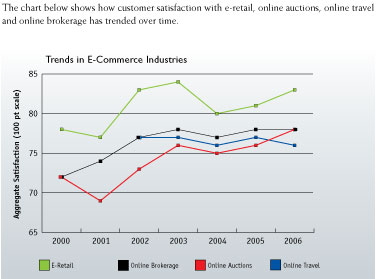Online retailers garner high customer satisfaction ratings

Customer satisfaction with the e-commerce industry improved for the second year in a row, according to the American Customer Satisfaction Index (ACSI), released today by the University of Michigan with e-commerce partner ForeSee Results.
The e-commerce industry overall rose to a score of 80 on ACSI’s 100-point scale, nearing its all-time high score of 80.8 achieved in 2003 and reflecting a continued outpacing of most other sectors of the economy in terms of satisfying customers; The national ACSI aggregate score is 74.9.
Every fourth quarter, the ACSI E-Commerce Report measures customer satisfaction within 1) online retail, 2) online auction, 3) online brokerage and 4) online travel companies.
I spoke with Larry Freed, CEO ForeSee Results, to discuss 2006 findings.

Online Retail
The e-commerce industry improved 2.5 percent to a 83 rating, led by a new high by BarnesandNoble.com (+1% to 88). Amazon.com remained at 87 for a second year and continues to be one of the “most satisfying companies” in all of the ACSI. Aggregate satisfaction for the e-commerce industry (83) still outpaces the offline retail sector (74.4) by 11.6 percent, according to the study.
Freed noted that “consumers will go where they are most satisfied” and they are feeling more and more empowered online.
Online Auction
The aggregate customer satisfaction score for online auction remained at 78 for a second year. Industry leader eBay maintained its leadership position, despite a 1 percent drop to 80.
Freed underscored “eBay is winning the auction category handily, but should be worried that they are still considerably behind Amazon.com, since the two companies increasingly compete.”
As the lines between auction sites and retail sites get more blurred every year, eBay will need to bring more innovation to satisfy customers like more traditional retailers do, Freed believes.
Online Brokerage
Customer satisfaction with online financial services hit a new all-time high, increasing 2.6 percent to 78. CharlesSchwab.com was the biggest gainer, improving 8 percent to 80 and setting a new high for the industry. E*TRADE also improved, up 4 percent to 74. Fidelity debuted with a ranking of 80, TD Ameritrade debuted at 77.
Freed expressed enthusiasm for online brokerage: “There is no better, faster, easier, or more convenient research tool than the web, which means investment companies have enormous potential to use their websites to serve customers in the best possible way.”
Online Travel
Online travel is the only industry in e-commerce that slipped in customer satisfaction, according to the report. In aggregate, online travel was down 1.3 percent to 76. Expedia fell to 78 and Travelocity to 74. Orbitz registered the only gain, +1.4 to 75.
Freed believes the aggregators are suffering due to a lack of competitive differentiation. “I think we’re going to see that this business model needs to adapt or these companies will be eclipsed by the supplier sites that are ultimately accountable for service delivery, Freed asserted.
ASCI METHODOLOGY
The ACSI uses customer interviews as input to a multi-equation econometric model developed at the University of Michigan's Ross School of Business. The ACSI model is a cause-and-effect model with indices for drivers of satisfaction on the left side (customer expectations, perceived quality, and perceived value), satisfaction (ACSI) in the center, and outcomes of satisfaction on the right side (customer complaints and customer loyalty, including customer retention and price tolerance).
The indices (shown in the diagram below) are multivariable components measured by several questions that are weighted within the model. The questions assess customer evaluations of the determinants of each index. Indices are reported on a 0 to 100 scale. The survey and modeling methodology quantifies the strength of the effect of the index on the left to the one to which the arrow points on the right. These arrows represent "impacts."
The ACSI model is self-weighting to maximize the explanation of customer satisfaction (ACSI) on customer loyalty. Looking at the indices and impacts, users can determine which drivers of satisfaction, if improved, would have the most effect on customer loyalty.
Customer loyalty is a combination of the customer's professed likelihood to repurchase from the same supplier in the future, and the likelihood to purchase a company’s products or services at various price points (price tolerance).
Customer loyalty is the critical component of the model as it stands as a proxy for profitability.